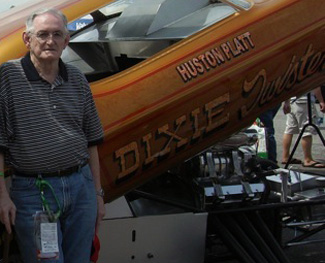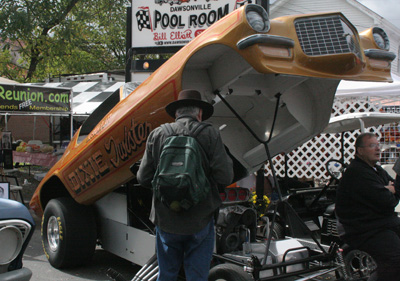
Georgia's Huston Platt poses with his Funny Car, the restored Dixie Twister. Photo courtesy Racin' Today.com
By Rick Minter-Guest Contributor
Posted in Feature Stories 12/17/10
Georgia Drag Racer Huston Platt’s 2009 induction into the East Coast Drag Times Hall of Fame was yet another sign that the 77-year-old former drag racer and his family are finally able to begin moving past one of their family’s and auto racing’s darkest days.
It’s mostly due to the unselfish efforts of one of Platt’s former crew members, Randall Davis.
I first met Davis in 2008, when he and I showed up at Platt’s home near Atlanta. I brought a notepad and tape recorder. He brought the Dixie Twister, Platt’s old Funny Car, which he had found under a tarp in a building in Nova Scotia and restored to its original condition.
I was reluctant about the whole thing, given Platt’s extreme unhappiness with his previous dealings with the media. But when Davis rolled the gold Camaro off the trailer, it seemed to put everyone there at ease.
The Platts and Davis laughed and smiled as they reminisced about their glory years in the 1960s, when Platt’s drag cars were among the fastest Chevrolets in America and he was in such demand that a Chicago-based agent handled his bookings.
They talked about racing against – and beating – the big-name drag racers of the day and winning match races against NASCAR stars such as Richard Petty, even though the Platt cars usually lacked the factory backing others had.
“I beat ‘em all,” Platt said.
They also talked about life on the road, about the night they ran out of gas on the way to a track in Canada and siphoned enough from a farm tractor to make it to the next town.
Jordon Platt tried on his grandfather’s old helmet and checked out every inch of the car. Rocky Platt gently turned the pages of an old scrapbook filled with yellowing newspaper accounts of his father’s many triumphs.
The scene was made possible because in restoring the Dixie Twister, Davis also restored its driver. Seeing his old car in its former glory has brought Huston Platt back to the sport he once loved.
For many years before, drag racing was something that was rarely discussed in the Platt household. That was because of the events of March 2, 1969, at Yellow River Dragstrip in Covington, Ga.
Huston Platt was in the Twister racing Frank Oglesby on a narrow, sandy track. Fans crowded to within a few feet of the track to get a better view of the cars. Some were literally hanging on tree limbs.
Witnesses said one of those fans reached onto the track to retrieve a beer can just as Platt deployed his parachute to slow his car. The opened parachute swept up the man, killing him instantly.
The weight of the victim against the parachute yanked Platt’s car into the spectator area. Twelve people died, and more than 40 more were injured. It remains the worst racing disaster on U.S. soil. Yellow River, one of Georgia’s most popular tracks, never held another race.
Investigators determined that unsafe track conditions were to blame. Racing, as it has done throughout history, had outrun the safety measures of the day. But the incident led to sweeping safety reforms in all types of motorsports. New legislation required tracks to be carry insurance, and the insurance companies helped ensure the safety of fans and competitors. Even NASCAR founder Bill France found himself testifying before legislators on behalf of the racing community.
“It was going to happen,” Platt said quietly the afternoon I interviewed him. “It was just a matter of when and where. There wasn’t a track in 10 states that was qualified to run those cars back then.
“It was a bad thing, but it led to safe racing, if you can say it’s safe.”
Other than the damage to the fiberglass body, Platt’s car, which he was racing for the first time, wasn’t seriously damaged. Investigators looked at every part and determined that there was no fault with the vehicle.
Still, the incident weighed heavily on Platt, for years and years after the crash.
“I’ve got feelings just like everybody else,” he said.
Platt raced on for a couple of seasons after Yellow River but grew tired of trying to outrun the powerful Chrysler hemi engines of that era. He sold his car and tried to forget about racing.
“When I gave it up, I didn’t want to talk about it,” he said. “The only time racing ever came up, it was always about Yellow River. I just shut it out completely. …
“I got my mind on other things, worked, played golf. I didn’t even think about racing or watch it on TV until a few years ago.”

The Dixie Twister is a popular car to check out wherever it goes. Photo by Brandon Reed
He and Davis drifted apart and eventually lost track of each other, but Davis often thought of his old racing hero.
“He was like a daddy to me,” Davis said.
A few years back, Davis began searching for the old Dixie Twister. Every lead turned cold. Then a tip led him to Nova Scotia. Knowing the car as he did, he checked it thoroughly and realized he’d found the Twister.
He brought it home and painstakingly restored it. Once it was done, but before he put Platt’s name over the door, he called him to seek his approval.
A date was agreed upon, and Davis took the car to Platt’s home. Only afterward did the Platts realize that the date was 39 years to the day after the Yellow River crash.
Rocky Platt was worried about his father’s initial reaction, but only for a moment.
“He stood straight up and smiled,” Rocky said. “It was amazing. Even my kids noticed the look on his face.”
The man who once tried so hard to avoid racing, now wanted to be a part of it again.
“It was a pretty good feeling,” Huston said. “I wanted to get back in the car.”
After Davis left, Platt’s grandsons searched the Internet for information about his career. They were stunned at the amount of information posted.
Bob Frey, the longtime traveling announcer for the National Hot Rod Association, said Platt, along with his brother, Hubert, were key players in the formative years of drag racing.
“He was as much a part of the fabric of the sport in the beginning as anybody,” Frey said. “He and his brother were colorful characters with good operations.”
Two years ago, for the first time since 1975, Huston Platt went back to the races. He attended the Southern Nationals at Atlanta Dragway, where he spent an afternoon joking with old friends, shaking hands with fans, signing autographs and posing for pictures. Only one person mentioned the crash.
“The car has changed that,” Rocky Platt said. “I can’t thank Randall enough. Now the good stuff can come up, and we can get past the Yellow River thing.”
Davis said that afternoon that all the time and money he spent on the car has been well worth it.
“To see Huston smile when we cranked it up was enough for me,” he said. “As long as it brings back any good memories for him, that’s all I care about.
“It’s not for me. It’s for Huston.”
Editor’s note: This story was originally published at Racin’ Today.com on September 30, 2009.
Rick Minter is an award-winning sports journalist who began covering motorsports for the The Atlanta Journal-Constitution in 1991, as well as serving as a bureau chief. Minter focused on racing exclusively from 2000-2008 . Minter and his wife Joanne live on the family farm in Inman, Georgia. In his spare time he collects and restores antique tractors and trucks.
Questions, comments, suggestions? Email us!
This website is not affiliated with or endorsed by the Georgia Racing Hall of Fame or the Georgia Auto Racing Hall of Fame Association, Inc. All content is the intellectual property of the individual authors. All opinions are those of the individual authors. Please do not repost images or text without permission.
